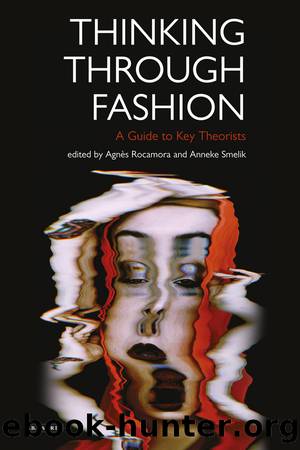Thinking Through Fashion by Agnès Rocamora

Author:Agnès Rocamora
Language: eng
Format: epub
Publisher: Bloomsbury Publishing
Goffman’s Interaction Order
While Goffman had a profound influence on most of the social sciences and he is cited everywhere, he is rarely discussed in detail. Nearly all social scientists can say something about many of his received concepts, but few investigated his ideas on their own terms. Social scientists tended to appropriate parts of his work that bear substantively on their own interests (Fine and Manning, 2003). But as Manning contends: ‘Goffman’s ideas have been instanced as illustrating this or that theory rather than a brilliant, unique and masterful evocation of the central dilemma – posed as a question – of modern life: what do we owe each other?’ (Manning, 2008: 677–78).
Addressing a fundamental sociological question, ‘what makes social order possible?’, Goffman outlined a system of an interactional order made up of a set of implicit instructions that govern our behaviour. In Relations in Public he observed that ‘even quite formalized codes, such as the one regulating traffic on roads, leaves many matters tacit’ (1971: 126). Take for example how we dress in the privacy of our own home; even then we choose what to wear by taking into consideration social demands and expectations. Those implicit codes and unspoken norms are at work when we unintentionally overdress or underdress. They are grounded in a moral system designed to save the face of all participants in the interaction. This moral system reflects the needs of the self to be recognized and sustained, and is based on mutually binding codes of obligations to self and other. These ground our confidence and trust in the social world by lending to it a quality of predictability, solidity and order. In his 1982 presidential address to the American Sociological Association, delivered shortly before his death, Goffman referred to his project of formalising the grammar rules of interaction order: ‘My concern over the years has been to promote acceptance of this face-to-face domain as an analytically viable one – a domain which might be titled, for want of any happy name, the interaction order – a domain whose preferred method of study is microanalysis’ (1983: 2).
The laws of the interaction order that Goffman articulated are actually quite visible in the realm of fashion. In Dress, Law and Naked Truth (2013), Watt makes an analogy between law and fashion. He notes that the ordering of bodily appearance arranges us for purposes of protection and projection. He then brings an example of a naked rambler who was jailed in Scotland for doing what he thought was his right: walking without clothes along a public path. The rambler defines it as ‘the problem to be yourself’. When he chose to come to the hearing naked, he was incarcerated for contempt of court, ‘public indecency’ and ‘breach of peace’. Watt argues that the underlying attitudes revealed in such cases are that nakedness is indecent, and that dress is invested with authority to police moral boundaries. This shows how inseparable dress is from civil order. This aspect of our taken-for-granted everyday
Download
This site does not store any files on its server. We only index and link to content provided by other sites. Please contact the content providers to delete copyright contents if any and email us, we'll remove relevant links or contents immediately.
| Advertising | Annuals |
| Book Design | Branding & Logo Design |
| Fashion Design | Illustration |
| Science Illustration |
Wonder by R.J. Palacio(7732)
Unlabel: Selling You Without Selling Out by Marc Ecko(2981)
POP by Steven Heller(2884)
Hidden Persuasion: 33 psychological influence techniques in advertising by Marc Andrews & Matthijs van Leeuwen & Rick van Baaren(2778)
The Pixar Touch by David A. Price(2740)
Ogilvy on Advertising by David Ogilvy(2682)
Drawing Cutting Edge Anatomy by Christopher Hart(2677)
Slugfest by Reed Tucker(2417)
The Art of War Visualized by Jessica Hagy(2412)
The Curated Closet by Anuschka Rees(2385)
Stacked Decks by The Rotenberg Collection(2270)
The Wardrobe Wakeup by Lois Joy Johnson(2235)
365 Days of Wonder by R.J. Palacio(2233)
The Code Book by Simon Singh(2210)
Rapid Viz: A New Method for the Rapid Visualization of Ideas by Kurt Hanks & Larry Belliston(2195)
Tell Me More by Kelly Corrigan(2195)
Keep Going by Austin Kleon(2161)
Tattoo Art by Doralba Picerno(2083)
Tokyo Geek's Guide: Manga, Anime, Gaming, Cosplay, Toys, Idols & More - The Ultimate Guide to Japan's Otaku Culture by Simone Gianni(1946)
